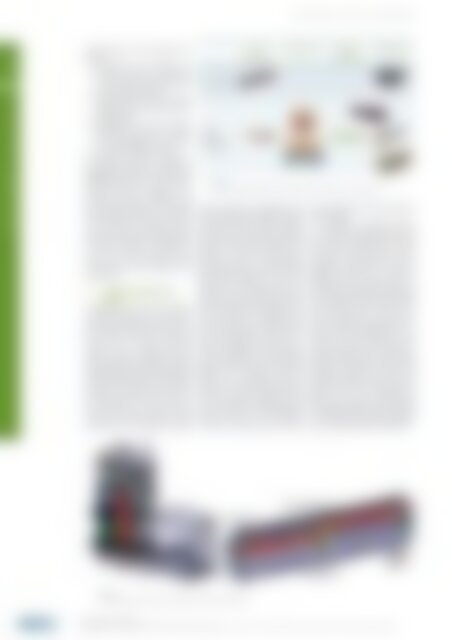Sie wollen auch ein ePaper? Erhöhen Sie die Reichweite Ihrer Titel.
YUMPU macht aus Druck-PDFs automatisch weboptimierte ePaper, die Google liebt.
<strong>atw</strong> Vol. 62 (<strong>2017</strong>) | Issue 8/9 ı August/September<br />
ENVIRONMENT AND SAFETY 532<br />
of the project can be summarized as<br />
follows:<br />
1) Development and validation of<br />
advanced numerical approaches<br />
for the design and safety evaluation<br />
of advanced reactors.<br />
2) Achievement of a new or extended<br />
validation base by creation of new<br />
reference data.<br />
3) Establishment of Best Practice<br />
Guidelines, Verification & Validation<br />
methodologies, and Uncertainty<br />
Quantification methods.<br />
The project consortium consists of<br />
23 European partners as depicted in<br />
Figure 2. Early 2016, an international<br />
collaboration with the US Nuclear<br />
Energy Advanced Modelling and<br />
Simulation program (NEAMS) has<br />
been initiated allowing to combine<br />
thermal hydraulic forces on both sides<br />
of the Atlantic. The project ensures<br />
relevance and contact with the system<br />
designers through the establishment<br />
of a Senior Advisory Committee in<br />
which the main European liquid<br />
metal cooled reactor designers are<br />
represented.<br />
3 Temperature fluctuations<br />
A fundamental issue for the evaluation<br />
of liquid metal reactors is the modelling<br />
of the turbulent heat transfer over<br />
the complete range, from natural to<br />
mixed and to forced convection<br />
regimes. Current engineering tools<br />
apply statistical turbulence closures<br />
and adopt the concept of the turbulent<br />
Prandtl number based on the Reynolds<br />
analogy. This analogy is valid mainly<br />
for forced convective flows with a<br />
Prandtl number of order of unity. In<br />
the particular case of liquid metal,<br />
where the Prandtl number is much<br />
smaller than 1, the turbulent Prandtl<br />
Experiment<br />
High-<br />
Fidelity<br />
Reference<br />
Simulation<br />
Flow<br />
Separation<br />
Shear / Jet<br />
number concept is not applicable, and<br />
robust engineering turbulence models<br />
are needed. Thus, a model is required<br />
which can deal with all flow regimes<br />
simultaneously in liquid metal flows.<br />
Roelofs et al. [2015] identified some<br />
promising routes for improvement<br />
which are tested on relevant available<br />
geometrically simple test cases. The<br />
main focus in Europe is now on the<br />
extension of the validation base for<br />
mixed and natural convection regimes<br />
and for geometrically complex cases.<br />
To this purpose, the validation base<br />
will be extended by including mixing<br />
jets, flow separation, mixed convection,<br />
and rod bundle test cases as summarized<br />
in Table 1. The preparation<br />
of the experiments and of the high<br />
fidelity Direct Numerical Simulations<br />
(DNS) are in progress and new<br />
reference data sets produced by these<br />
efforts are currently being produced<br />
and will become available in the<br />
second half of <strong>2017</strong> and 2018. Figure 3<br />
shows a 3D view of the design of<br />
a backward facing step test section<br />
Mixed<br />
Convection<br />
| | Tab. 1.<br />
Summary of SESAME reference data for turbulence model assessment to be generated.<br />
Rod Bundle<br />
to be installed in the German KASOLA<br />
sodium facility.<br />
In addition, a pragmatic simulation<br />
model which performs well in all<br />
flow regimes simultaneously would<br />
provide much added value. Further<br />
assessment and development of the<br />
promising approaches is foreseen.<br />
Emphasis is put on the creation of<br />
missing relevant reference data, on<br />
more robust testing of the models and<br />
on testing the models in geometrically<br />
more complex cases. Some of the<br />
selected approaches will provide a<br />
more pragmatic computational alternative<br />
to the high fidelity but very<br />
expensive LES. As such LES is practically<br />
not possible for the prediction of<br />
thermal fluctuations in a wide range<br />
of flows, as is required in most cases of<br />
industrial interest. This work will<br />
therefore probably also have a positive<br />
impact also on the simulation of<br />
light water reactors. The following<br />
promising models identified in Roelofs<br />
et al. [2015] will be further developed<br />
and/or implemented and validated:<br />
| | Fig. 3.<br />
KASOLA facility at KIT (left) and it’s backward facing step test section (right).<br />
Environment and Safety<br />
The SESAME Project: State of the Art Liquid Metal Thermal Hydraulics and Beyond ı F. Roelofs, A. Shams, A. Batta, V. Moreau, I. Di Piazza, A. Gerschenfeld, P. Planquart and M. Tarantino

















